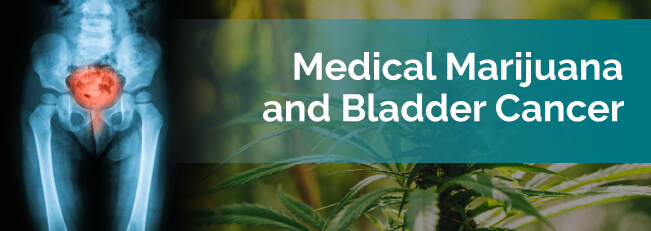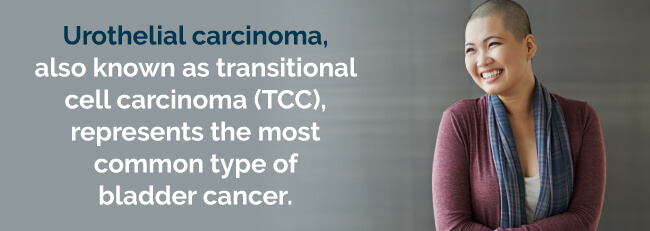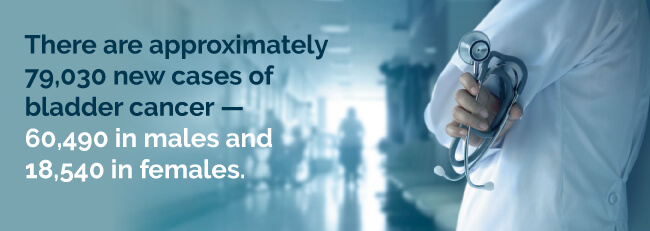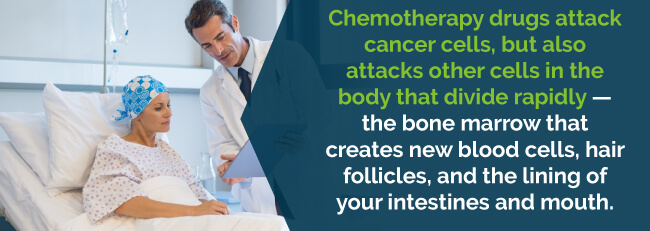
If your oncologist has diagnosed you with bladder cancer, you’ll want to know about the many treatment options available. Bladder cancer occurs when cells in your urinary bladder begin to grow uncontrollably. Also called bladder carcinoma, bladder cancer typically occurs in older individuals. Seeing blood in your urine is often the first sign of bladder cancer.
Read on to learn more about cancer and how medical marijuana for bladder cancer can help alleviate your symptoms.
The urinary system is composed of two kidneys, two ureters, the bladder and the urethra. The kidneys remove waste products from the blood and form urine. Urine then travels through the tube-like ureters and is stored in the bladder before it is eliminated from the body via the urethra. The bladder is the hollow-shaped organ that expands and contracts to collect and eliminate urine. As with all organs in the urinary system, the bladder is susceptible to developing cancer, the uncontrolled growth of abnormal cells. The wall of the bladder has several layers of tissue. Bladder cancer type depends on the types of cells and layers of tissue affected. There are three types of bladder cancer. Transitional cell: This type of cancer begins in the transitional cells. These cells form the innermost layer of the bladder, allowing the bladder to stretch when it is full and shrink when it is empty. It is the most common site of bladder cancer. Squamous cell: This type of cancer is a slow-growing cancer of the thin, flat cells that line the surface of the bladder. Adenocarcinoma: Cancer that begins in the glandular or secretory cells of the bladder. Symptoms of bladder cancer can include: blood in urine, frequent urination or feeling the need to urinate without being able to do so, pain during urination. Men are more likely to develop bladder cancer than women. Bladder cancer is more common in whites than in blacks. Risk factors for bladder cancer include smoking tobacco, long-term exposure to certain workplace chemicals or carcinogens such as those used in making rubber, textiles, paints and dyed clothing, a diet high in fats and fried foods, having a history of recurrent bladder infections, long-term use of urinary catheters, being over age 60. If cancer is suspected, diagnostic studies can include cystoscopy, an imaging study where a tube with a lens is placed into the bladder through the urethra. Urine culture and cytology, laboratory studies that analyze urine for bacteria and cancer cells. Biopsy, the removal of bladder cells for examination under a microscope. Imaging studies such as MRI, CT scan, and IVU, intravenous urography, that provide a detailed picture of the urinary system. Treatment and prognosis depend on the stage and grade of the cancer and the location of the tumor. Treatment options for bladder cancer can include surgery, chemotherapy, radiation and biologic therapy. Learn more below about how medical marijuana can help treat bladder cancer.
Smoking cannabis correlates with lower rates of bladder cancer. In 2015, the journal Urology published the results of a study named that found pot smokers were 45 percent less likely to have a bladder cancer diagnosis than people who didn’t smoke. There are also anecdotal accounts of individuals who have found relief treating themselves with medical cannabis for bladder cancer.
Find A Doctor Find A Dispensary
Medical marijuana for bladder cancer can help elevate your mood and is also successful in treating pain and sleeplessness. Cannabis can also help with nausea and lack of appetite experienced when you have chemotherapy.
There’s no cookie-cutter approach when it comes to treating the symptoms of bladder cancer and its treatment side effects. What works well for a friend may not necessarily work for you. You may need to experiment before you find the right strain that suits you. The following strains of medical pot could help.
Chronic illness gets you down. If you’re feeling down in the dumps, these three strains might help:

For excellent pain relief, try these three strains:
Sleep disturbances are only natural when your oncologist informs you that you have bladder cancer. If you need to get more sleep, these heavy indica strains could help:
You can take cannabis for bladder cancer in various ways. These include:
The most important part of the medical marijuana experience is researching to improve your knowledge. Marijuana Doctors is your one-stop source for medical cannabis information, offering you numerous educational and research resources. Getting started with the medical marijuana process for bladder cancer requires basic knowledge about your local resources and state laws.
We encourage you to read more about the cannabis laws in your state, the dispensaries providing patients like you with quality cannabis products and the specially trained marijuana doctors in your location.
Find A Doctor Find A Dispensary
Your bladder is an organ in your pelvis that contains muscular, flexible walls. Its primary function is to store urine before it leaves your body. Your kidneys make urine that flows through tubes called ureters to your bladder.
When you urinate, your bladder muscles contract and urine leaves your bladder through the urethra. As cancerous cells develop, they can form a tumor. They can also spread to other areas of your body.
The majority of bladder cancers begin in the transitional epithelium, or urothelium, the innermost lining of your bladder. If your cancer grows into the other layers of your bladder wall, it can become more advanced and harder to treat.
Given time, cancer can spread to the bladder and into nearby structures. It could grow in your lymph nodes or to other body parts, such as the liver, bones or lymph nodes.
Several types of cancer begin in the bladder. These include the following.
Urothelial carcinoma, also known as transitional cell carcinoma (TCC), represents the most common type of bladder cancer. TCC begins in the urothelial cells on the inside of your bladder. You’ll find urothelial in other areas of your urinary tract, including in the part of the kidney that connects to your ureter, or renal pelvis, the urethra and the ureters.

People with bladder cancer can sometimes have other tumors in these areas. Therefore, your doctor must check your entire urinary tract for tumors.
Bladder cancers are usually described based on how far into the wall of the bladder they’ve invaded. There are two types:
Bladder cancers are either non-muscle invasive or superficial. Your doctor uses these terms to describe both invasive and non-invasive tumors that haven’t grown into the primary layer of bladder muscle.
Flat cancers don’t grow toward the hollow part of the bladder. If a flat tumor is only within the inner bladder cell layer, it’s known as non-invasive flat carcinoma or a flat carcinoma in situ (CIS).
Papillary carcinomas grow in finger-like, slender projections from the inner surface of your bladder toward the hollow center. Papillary tumors tend to grow toward the middle of your bladder and don’t tend to reach into the deeper bladder layers. These types of tumor are named non-invasive papillary cancers.
Slow growing, low grade non-invasive papillary cancer is also known as papillary urothelial neoplasm of low-malignant potential (PUNLMP). This type of cancer has a positive outlook for recovery. When a flat or papillary tumor grows into the deeper layers of your bladder, it’s known as an invasive urothelial (or transitional cell) carcinoma.
There are several other less-common kinds of cancer that can originate in your bladder. These are:

Bladder cancer has a long history. Let’s take a look at the bladder cancer timeline as provided by the American Society of Clinical Oncology.
You may suffer from the following physical and emotional effects if you have bladder cancer:
You may feel tired, anxious and depressed due to your illness. You may also stop going places due to needing to use the bathroom regularly. You could also feel embarrassed. You may not have the get-up-and-go you used to.
Keep in mind the above can be symptoms of various illnesses. If you have any of these symptoms, be sure to see a physician.
The American Cancer Society estimates the following statistics for bladder cancer in the U.S. for 2017:

ACS states new diagnoses of bladder cancers have shown a slight drop in females in recent years. In males, incidence rates have also decreased.
The treatment you receive depends on various factors, including the stage of cancer you have, your general health and more. Treatment options include the following.
Surgery is part of the treatment for many bladder cancers. The type of surgery you need depends on the stage of your cancer.
Surgeons use the procedure known as a transurethral resection to ascertain whether a person has bladder cancer. Doctors can also find out if the disease has invaded the layer of muscle of the bladder wall.
Transurethral resection of bladder tumor (TURBT) is the most common treatment for superficial (non-muscle invasive) or early-stage bladder cancers.
The side effects of the procedure are usually short-lived and mild. You may have pain and bleeding upon urination. In some cases, you may feel the urge to urinate more frequently, or you could become incontinent.
If you have recurring non-invasive low-grade tumors, your surgeon may burn these away during your cystoscopy in the doctor’s office. This procedure can be slightly uncomfortable.
Your surgeon removes part or all of the bladder through a procedure known as cystectomy. If the surgeon removes part of your bladder, the remaining section won’t hold the volume of urine it used to. As a result, you’ll feel the urge to go to the bathroom more regularly. Also, cancer could potentially recur in a different part of the bladder wall.
If you have a full bladder removal or radical cystectomy, you’re given a general anesthetic and need to stay in the hospital for around a week afterward. It’s crucial the surgeon performing your operation has experience treating bladder cancer. If surgery isn’t successful, the cancer could return.
If your surgeon removes your entire bladder, you need reconstructive surgery to store and remove urine from your body.
Cystectomy carries many of the risks of any major surgery. These include:
You could also experience sexual dysfunction. If you need to wear a urostomy bag, you run the risk of:
The doctor puts a liquid drug directly into your bladder via a catheter in intravesical therapy. There are two distinct types of intravesical therapy:

Chemotherapy drugs attack cells that divide quickly. Hence, the treatment works against cancer cells. It also attacks other cells in the body that divide rapidly — the bone marrow that creates new blood cells, hair follicles, and the lining of your intestines and mouth. Common chemotherapy side effects include:
Radiation therapy involves the use of high-energy radiation to kill cancer cells. It’s often combined with chemo to make the radiation more effective. Side effects of radiation can include:
These symptoms usually go away afterward. Some people go on to develop long-term problems after radiation therapy, like:
Immunotherapy involves the use of medicine to help your immune system pinpoint and destroy cancer cells.
Intravesical BCG can treat some early-stage cancers. The treatment activates immune system cells in your bladder. These then attack cancer cells.
Your immune system works with checkpoints. These are molecules on immune cells that need to either be on or off to start an immune response. There are exciting new drugs on the market that target these checkpoints. Some can slow tumor growth or even shrink tumors. Common side effects are:
Occasionally, the immune system may begin to attack other parts of your body. If you experience any worrying side effects, speak with your doctor.


Please allow us to access your location to find local dispensaries.
VIEW ALL DISPENSARIES ➔